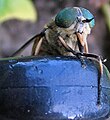Brakes
| Brakes | ||||||||||||
|---|---|---|---|---|---|---|---|---|---|---|---|---|

Rainfly ( Haematopota pluvialis ) |
||||||||||||
| Systematics | ||||||||||||
|
||||||||||||
| Scientific name | ||||||||||||
| Tabanidae | ||||||||||||
| Latreille , 1802 | ||||||||||||
| Subfamilies | ||||||||||||
Horseflies ( Tabanidae ) are a family from the suborder of the flies ( Brachycera ) in the order of the two-winged ( Diptera ) and belong to the blood-sucking ( haematophage ) insects ( Insecta ). They sting people and other animals of the same temperature or alternating temperature ( warm-blooded animals ). They are particularly active in Central Europe between April and August on humid days.
In northern Germany the brake is often also called Dase (cf. Dasselfliegen ) or blind fly , in western Germany blind cuckoo , in southern Germany and parts of Austria and Switzerland Bräme or Brämer , historically there is Brämse .
Lifestyle and diet
In most of the 4000 or so species, only the females suckle blood , while the males visit flowers and suckle nectar . One blood meal is enough for reproduction .
In some species (subfamily of the Pangoniae ), the females also feed on plants. Their proboscis is sometimes very long to get nectar. Some tropical species live on carrion .
The mouthparts of brakes to a stiletto proboscis transformed consisting labrum , hypopharynx , and the pair of mandibles and maxillae consists. The piercing bristles are enclosed from behind by the labium . In contrast to that of mosquitoes , the bite of horseflies is immediately noticeable and painful. They are usually so-called pool feeders , which use coarse mouthparts to tear an open wound into the skin. They feed on leaking blood, lymph and cell fluid. Itching occurs at the sting point . As with mosquito bites a form for a few hours wheal . Brakes are specially attracted by sweat and can also sting through clothing. Like many blood-sucking insects, they inject an anticoagulant secretion before sucking blood , which causes the relatively large stab wound to continue bleeding after sucking. Horseflies can suck up to 0.2 ml of blood.
Life cycle
25 to 1000 eggs are deposited on plants close to water. The larvae usually go through 6 to 13 developmental stages, sometimes live alternately predatory and on plant remains on / in the water and in the moist soil / mud until they pupate in drier places. The development cycle lasts from several months to several years, depending on the climatic zone. In Central Europe z. B. the Tabanids one generation, so have an annual cycle. The adult animals live 2 to 4 weeks.
Braking as a disease carrier
Brakes can mechanically transmit anthrax , Weil's disease , tularemia and Lyme borreliosis to humans through their sting , see also infection routes and blood-sucking insects .
The human pathogenic filaria Loa loa uses representatives of the horsefly subfamily Chrysopinae as intermediate hosts in West Africa .
The surra of horses and camels is transmitted mechanically by tabanids outside of the Tsetsi belt , just like the paralyzes of horses in South America.
Furthermore, brakes are suspected of mechanically transmitting nagana to animals and sleeping sickness to humans in Africa .
Horseflies ( Tabanus sudeticus ) to the can lentiviruses belonging EIA virus transmitted by mechanical means.
Genera and some Central European species
-
Chrysops
- Chrysops relictus , golden-eye fly
- Chrysops flavipes
- Silvius
- Pangonius
-
Tabanus , 40 species
- Tabanus bovinus , gadfly
- Tabanus bromius , Common Horsefly
- Tabanus sudeticus , horsefly
-
Haematopota
- Haematopota pluvialis , rainfly
- Heptatoma pellucens
Fossil evidence
Fossil evidence of this family is rare. The oldest confirmed evidence is Eocene age, from Baltic amber as well as from a geological layer of this age on the Isle of Wight . The genus Stenotabanus is described from the mostly somewhat younger Dominican amber . Brachycera found in Mesozoic deposits, which were once considered members of this family, are now assigned to other taxa .
See also
literature
- The fossil tabanids (Diptera Tabanidae): when they began to appreciate warm blood and when they began transmit diseases? PMID 12687759 .
- Seasonal prevalence of bovine trypanosomosis in a tsetse-infested zone and a tsetse-free zone of the Amhara Region, north-west Ethiopia. PMID 15732457 .
- Josef Boch, Christian Bauer: Veterinary Parasitology. Thieme, Stuttgart 2006, ISBN 3-8304-4135-5 .
- Dieter Matthes: Animal Parasites: Biology and Ecology , Springer-Verlag, Berlin a. a. 2013, ISBN 978-3-663-20186-1 .
Web links
- Fam.Tabanidae - Bremsen ( Memento from July 5th, 2008 in the Internet Archive )
Individual evidence
- ↑ Dieter Matthes: Animal Parasites: Biology and Ecology. Berlin [u. a.] 2013, p. 27.
- ^ Josef Boch, Christian Bauer: Veterinary Parasitology. Stuttgart 2006, p. 271 ff.
- ↑ Steven W. Luger: Lyme Disease Transmitted by a Biting Fly . In: The New England Journal of Medicine. Volume 322, No. 24, 1990, p. 1752.
- ↑ Oliver A. Radtke: The insects as constant players and opponents of humans ( Memento of March 7, 2005 in the Internet Archive ).
- ↑ Sir David Bruce. In: whonamedit.com
- ↑ Equine Infectious Anemia ( Memento of February 28, 2009 in the Internet Archive ) / transmission
- ↑ LD Foil, WV Adams, JM McManus, CJ Issel: Bloodmeal residues on mouthparts of Tabanus fuscicostatus (Diptera: Tabanidae) and the potential for mechanical transmission of pathogens. In: Journal of Medical Entomology (J Med Entomol.), November 1987, Volume 24, No. 6, pp. 613-616, doi: 10.1093 / jmedent / 24.6.613 .
- ^ George O. Poinar, Roberta Poinar: The amber forest: a reconstruction of a vanished world. Princeton University Press, Princeton NJ 1999, ISBN 0-691-02888-5
- ↑ Fossil Diptera Catalog - Web Version: Family TABANIDAE. On: hbs.bishopmuseum.org , last revision: September 15, 1996; Retrieved June 22, 2014
- ↑ George O. Poinar: Life in Amber . Stanford University Press, Stanford Cal 1992, ISBN 0-8047-2001-0




